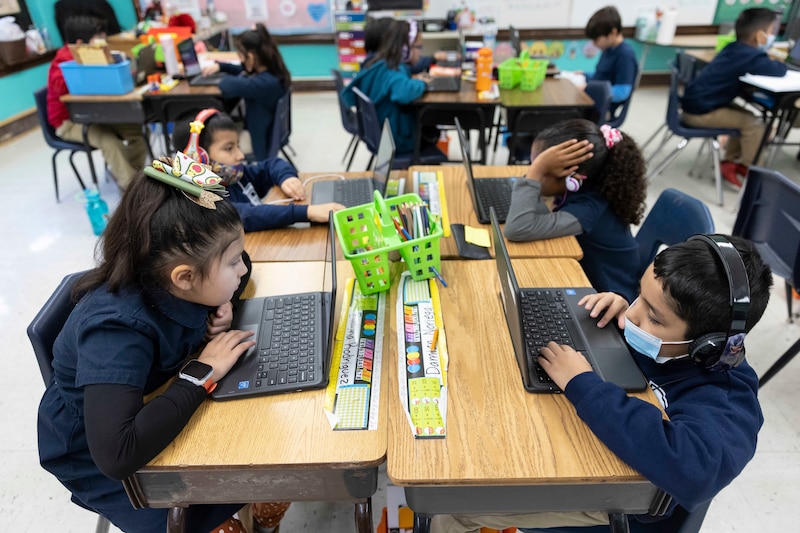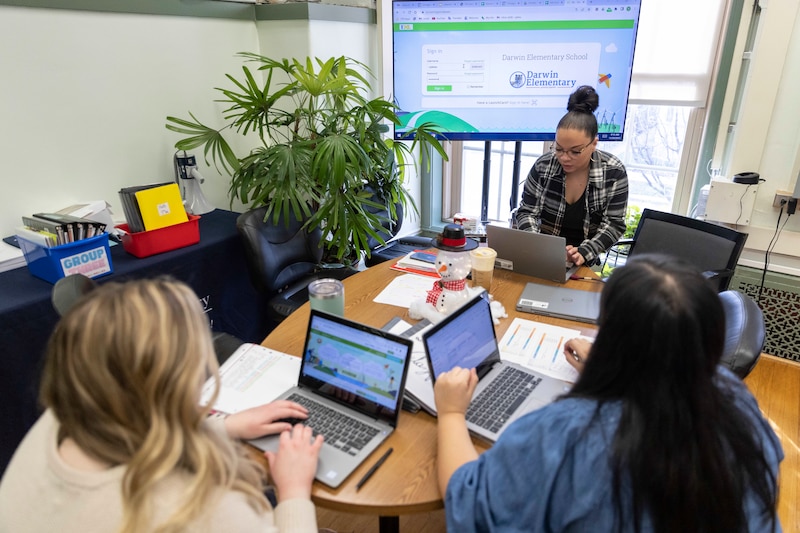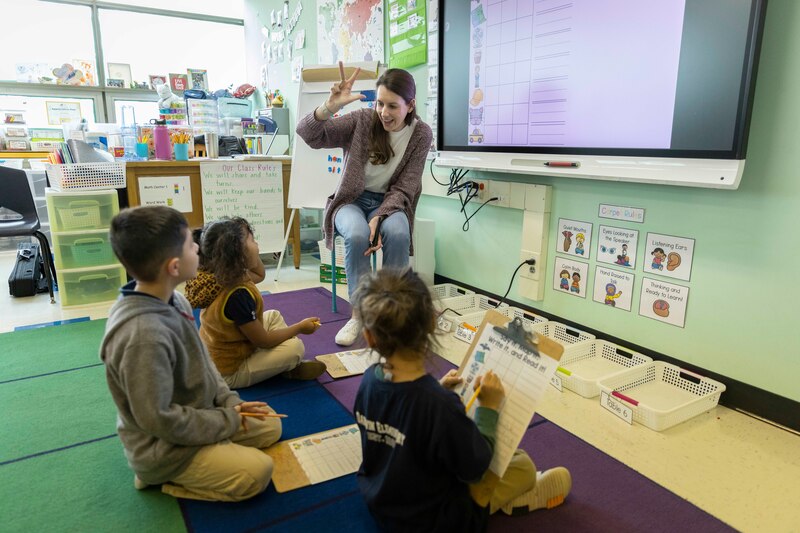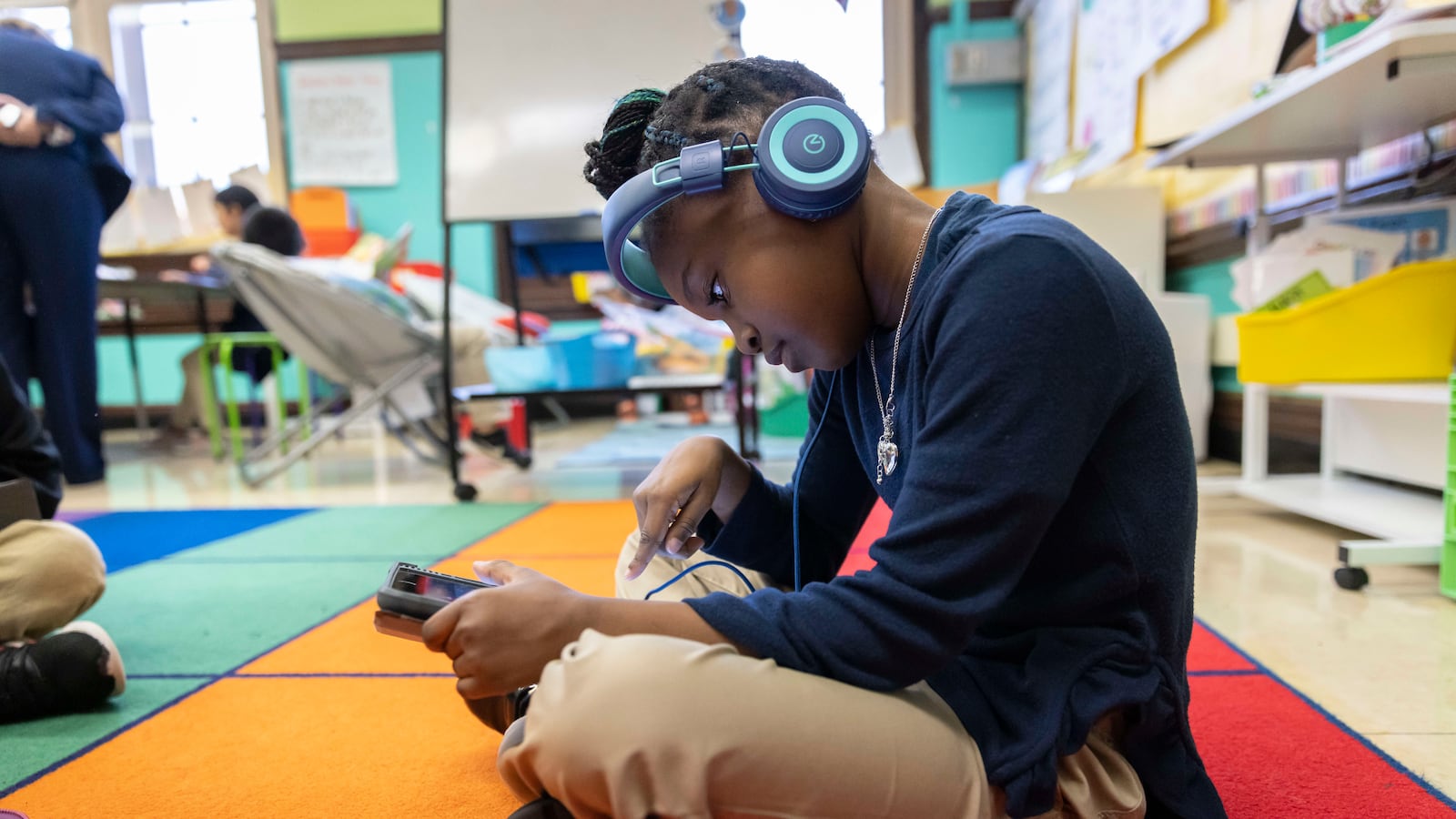The COVID-19 pandemic and a historic infusion of federal dollars spurred a technology revolution in Chicago’s public schools — a monumental shift from a district where students had limited access to computers to one where officials say there are as many devices as students.
Chicago Public Schools leaders say this allows teachers to implement a new high-quality curriculum and to give students essential digital skills.
But the district does not have a clear, detailed plan for using the new devices to improve instruction or a reliable system to track what technology campuses have and how they use it, Chalkbeat and WBEZ have found.
Chicago Public Schools has spent more than $308 million on computers and other technology from its three main vendors since the pandemic forced schools to pivot to remote instruction in March 2020 through August this year, according to purchase order data reviewed by Chalkbeat and WBEZ. That’s roughly as much as these companies got paid during the previous two decades combined.
Roughly 40% of that spending took place after students returned to campuses for in-person learning in September 2021, at a time when leadership changes left the district without a top IT official for more than a year.
After months of questioning by Chalkbeat and WBEZ and several inaccurate estimates, officials said last week that they bought nearly 311,000 laptops and tablets. More than 41,000 of the devices are sitting in a warehouse or yet to be shipped by a manufacturer, according to CPS.
Once computers get to the schools, the district has no systematic way to track how they are being used. CPS’ system for tracking device availability on its campuses isn’t regularly updated, and it does not offer meaningful information about whether computers are used at all, Chalkbeat and WBEZ found. The school district depends on schools to take a regular inventory, but the process is time-consuming, and only 35% of Chicago’s 500 district-run schools have a technology coordinator on staff, CPS data shows.
The district inspector general’s office is reviewing CPS’ system for tracking technology assets and reporting that information, the office told Chalkbeat and WBEZ.
Meanwhile, the lack of a systemwide digital learning plan has left some educators seeking guidance on how to incorporate the computers into learning — and in some cases, leaving hundreds of devices to gather dust in storage.
Chicago school leaders note the initial technology expansion took place during a challenging pandemic stretch. They also stress that they have a window into technology use across the district thanks to regular conversations with principals and teachers. And they say educators get leeway on how to use technology based on their classrooms’ needs and goals.
District officials — and some educators — say the access to technology has been a crucial step forward, allowing schools to better gauge how much students are learning and to intervene with support tailored to their needs. That greater access has also been essential as Chicago Public Schools rolled out a $135 million Skyline curriculum for every grade and subject beginning last year.
But experts worry Chicago and other districts tapped federal pandemic recovery funds to amass devices without a strategy for making smart use of them or for replacing outdated computers once the money runs out. Chicago doesn’t have a long-term plan for updating and replacing computers. Instead, officials say they are hoping to persuade the federal government to keep chipping in.
Chicago officials say they are now working on a digital learning plan that would spell out how computers can better power student instruction, building on work they say began before the pandemic. They also say they expect to offer ongoing coaching and professional development for staff.
“I think it’s worthwhile to take a pause and look at what we’re doing here and make sure that the plan for the future is the right trajectory,” said Edward Wagner, deputy chief of Information Technology Services.
Chicago spends big after decades of device disparities
Teacher Daphne Whitington spent years dreaming of bringing an Advanced Placement research class to Julian High School on the Far South Side.
That wasn’t possible before COVID. Her school, serving a predominantly Black, largely low-income student body, never had enough computers, which are needed to scour peer-reviewed journals online and to organize findings.
On the eve of the pandemic, Whitington said the school had a room designated as a computer lab — full of woefully outdated PCs, most of which didn’t work.
“Having digital competency is a necessary part of education now,” she said. “It felt like a profound disparity prior to COVID. It felt like a blatant racial injustice.”
The district’s technology spending was already on the rise at the onset of the pandemic. Still, when COVID hit, only about 40% of Chicago Public Schools students had access to a computer for remote learning, according to documents the district provided to the federal government.
The COVID-19 outbreak set off a scramble to get devices into students’ hands. Some of the $2.8 billion in federal COVID relief funds Chicago Public Schools received powered the push.
The district also got $83.5 million through the federal Emergency Connectivity Fund, an effort to support district spending on devices and wireless access during the pandemic that gave districts fairly tight deadlines to use the money or lose it.
Even after students returned to campuses full time, the district continued to pour tens of millions of dollars into technology. It has spent $123 million on its three main technology vendors — CDW, Apple, and Virtucom — since in-person learning resumed in August 2021, according to purchase order data obtained by Chalkbeat and WBEZ. Most has been spent on laptops and tablets, though the district also bought interactive boards, headphones, projectors, video game consoles, and more. Overall, technology behemoth CDW Government, headquartered in Vernon Hills, is the outside vendor that received the most federal COVID relief money.
In recent weeks, the district struggled to provide Chalkbeat and WBEZ with a total for the devices it bought and handed out to schools. Of the 311,000 devices purchased, CPS says about 270,000 are tagged and assigned to a school or department.
It’s hard to confirm from district data CPS’ claim that it now has a device for each student. Many campuses have received significantly fewer devices since March 2020 than the number of students enrolled, though that might reflect disparities in technology available when COVID hit. The district says it can only estimate how many functioning devices appropriate for remote learning it had pre-pandemic.

The influx of technology transformed the district
Inside Darwin Elementary School in Chicago on a recent Tuesday morning, one third grade classroom is nearly silent. Students are taking a math test on their laptops. Big headphones cover their ears.
In the other third grade classroom, a smartboard displays a list of discussion questions. The teacher leads a conversation about a book on the Great Chicago Fire.
“What does it mean to be uneasy?” she asks the class, telling them to draw on earlier lessons when they learned about feelings.
For years, Darwin had to dip into its school budget to provide computers to its mostly low-income Latino students. Then came the pandemic-era influx of devices. Now, the school has a Chromebook for each of its roughly 540 students.
This allows teachers to target instruction for individual students, Principal Daniel De Los Reyes said.
“So this differentiated instruction is actually at the core of what I feel is needed and technology allows us to dig further into that and actually live that out a bit more,” he said.
The federal windfall has meant schools like Darwin no longer have to pay for iPads and Chromebooks out of their own budgets, which gave an edge to wealthier schools that could fundraise for technology. The district now handles all device purchases centrally, officials said. That has helped it to address disparities and to ensure schools are prepared if another pandemic or even a major snowstorm abruptly shutters buildings, Wagner said.
District leaders also say a key rationale for the spending spree is the 2021 rollout of Skyline, the district’s digital curriculum bank — a project conceived on the cusp of the pandemic to give campuses easier access to quality, culturally relevant lessons. Skyline adoption is voluntary, but the district has been leaning more on schools to use it, and data shows Skyline usage increased tenfold this fall compared to last fall.
Skyline lessons can be and — in many cases — should be taught offline with students interacting and writing on paper, especially in the elementary grades. But Mary Beck, acting director of teaching and learning for CPS, says online features can enhance the learning experience. Skyline’s tests are available online, and educators can customize lessons and assignments to fit their students’ needs.
Some educators say this expanded access to technology has been transformational.
Thanks to the arrival of tablets for each student, Whitington was finally able to launch her AP research class last year. This fall, her juniors settled on research topics together, from laws that ban discrimination against natural hair styles to the lack of education on climate change in low-income schools. They are investigating them together online and collaborating even after the class is over.
But, she says, whether devices truly elevate learning is sometimes up to tech-savvy educators.
“Teachers who take an active interest in technology are going to be fine,” she said. “CPS needs to make sure that happens for everyone. I don’t think that’s happening at the moment.”

No strategy, support as schools face ‘PTSD with the screens’
At one Chicago elementary school, a sizable shipment of devices arrived this fall. The principal, who asked to remain anonymous in order to speak candidly, said he didn’t ask for them.
But he can guess what happened.
Without a technology coordinator at the school, the “overwhelming” task of updating the district’s inventory system falls to him. He didn’t get around to logging some of the computers his school already had, so the district shipped more.
Only 174 of 500 district schools have technology coordinators, the district’s most recent staffing data shows. In addition, while some of the district’s massive spending on tech was underway, its top IT job sat vacant for more than a year. It was finally filled in October.
Meanwhile, educators at that principal’s school are often unsure how to meaningfully incorporate the computers into day-to-day learning. Some feel lingering technology fatigue after a challenging virtual learning stretch — a condition the principal described as “PTSD with the screens.”
Hundreds of computers from that fall shipment sit in a back room at his school.
“We have a lot of technology that kids are using to do school research and play games,” he said.
That school’s experience captures the challenges facing schools as the influx of technology has outpaced the district’s capacity to plan and strategize. In the absence of clear expectations, some educators are either passing on using the devices or using them in ways that don’t truly advance learning.
Several principals told Chalkbeat and WBEZ they got more devices than they know what to do with this fall. Wagner, the district’s deputy technology chief, said his department can tell which devices have been turned on at least once through its tracking system, but has no way to know if they are in regular use.
The district’s device inventory is its best window into tech availability across the city. But updating it can be a tall task in schools with hundreds — sometimes thousands — of students and devices.
Schools are encouraged to assign computers to students or educators who need them, marking those devices as “in use.” In the data provided to Chalkbeat and WBEZ with nearly 270,000 devices, only 86,000 — about one-third — are marked “in use.” The bulk of the devices, 170,000, are listed as “available.”
District officials and some principals stress most of those devices marked “available” are actually being used, but that either no one is changing the status or the computer is just not assigned to a specific student.
The remaining roughly 15,000 computers are marked as lost, stolen, recycled, or in repairs, the log of devices purchased since March 2020 shows.
The district also conducts an annual technology audit to get a firm count of its device inventory. But when Chalkbeat and WBEZ submitted a public records request for the latest audit from last spring, the district provided a one-page document that simply lists the number of schools that turned in any information on their assets for the audit. Still, the district says it will have a clearer picture of its device distribution once the latest audit is complete this coming spring.
In the midst of that annual audit process this fall, the principal at Jamieson Elementary School emailed families to say the Northwest Side school could not account for more than 100 Chromebooks, and asked families whose students might have borrowed them to return them.
Meanwhile, some educators say they need more guidance on using this more plentiful technology.
To some, the moment feels like a missed opportunity. Educators got more tech-savvy during the pandemic, and some used computers in innovative ways.
Hal Friedlander, of the nonprofit Technology for Education Consortium, said, ideally, district technology and education leaders, with input from teachers and experts, would work together to come up with a plan before buying devices. But COVID created an urgent demand and left little time for planning.

Experts caution districts need blueprints and accountability
De Los Reyes, the Darwin principal, said district leaders have not given him and other school leaders instructions for using the technology in classrooms. But he believes the district should strike a balance between setting expectations and letting individual schools pick an approach that works best for their students.
In the younger grades, interacting with teachers and fellow students, as well as learning to write with a pencil, are crucial, he noted. But as students get older, using devices is a key skill they need as they go off to high school, college, and, eventually, into the workforce.
For teachers at Darwin, the influx of new technology has been a huge help.
They can see where students are struggling through the Skyline assessments students take on their devices. Then students get help online tailored to close those gaps.
“It allows us to put a pulse on achievement,” De Los Reyes said. “When you have one-to-one technology, we now have platforms where students can access their learning plan specific to their needs.”
District officials say they want what is happening at Darwin repeated across the district. Beck said she encourages principals to be thoughtful about incorporating technology into a student’s day.
“It’s not that a student is on a computer the entire time sitting next to somebody,” she said. “We really want teachers to adapt to the lesson and the content. You’ll see that students will close their Chromebooks and engage in conversation. It’s using it as a tool.”
Still, Beck insists “being one-on-one is vital.” She and other officials say it made sense to take advantage of available funding to get there.
But, experts say, simply purchasing computers is not enough. Districts need a strategy for use.
Joseph South, chief learning officer for International Society for Technology in Education, a nonprofit that advocates for the smarter use of classroom tech, said he sees an often fractured and passive use of technology in districts around the country, with devices being used as little more than TV sets.
Instead, he said, students should be using devices to “create, to problem solve, to communicate, to bring in experts from outside the four walls of the classroom.”
Too often, South said, the district technology leader will buy “stacks of devices, and send them out to schools and says, ‘OK, I’ve done my job.’ ”
“That’s actually a really ineffective way of deploying technology,” he said.
But often that’s what happens, said Bart Epstein, an expert at the University of Virginia and head of the nonprofit EdTech Evidence Exchange. School districts don’t know how often or how well students are using devices once they’re purchased.
He likened it to what would happen if districts bought a fleet of buses and parked them in a lot while students walked to school. The public, he says, would be outraged.
Mila Koumpilova is Chalkbeat Chicago’s senior reporter covering Chicago Public Schools. Contact Mila at mkoumpilova@chalkbeat.org.
Sarah Karp covers education for WBEZ. Follow her on Twitter @WBEZeducation and @sskedreporter.

